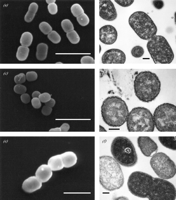
Таксономия
Psychrobacter arcticus 273-4
бактерия Bacteria
группа Proteobacteria
класс Gammaproteobacteria
порядок Pseudomonadales
семейство Moraxellaceae
род Psychrobacter
вид Psychrobacter arcticus
штамм 273-4
Temporal shifts of the Norway lobster (Nephrops norvegicus) gut bacterial communities.
Meziti A, Ramette A, Mente E, Kormas KA.
Department of Ichthyology and Aquatic Environment, University of Thessaly, Magnisia, Greece Max Planck Institute
for Marine Microbiology, Bremen, Germany School of Biological Sciences, University of Aberdeen, Aberdeen, Scotland,
UK.
Abstract
The aim of this study was to investigate the gut bacterial communities of Nephrops norvegicus individuals, using a
suite of molecular tools consisting of automated ribosomal intergenic spacer analysis, 16S rRNA gene-internal
transcribed spacer clone libraries and FISH. The animals were collected from Pagasitikos Gulf, Greece, during
different months of the year. The diversity of the gut bacterial communities was found to mostly vary with sampling
time, which could be related to temporal variations in food supply. The 16S rRNA gene diversity analysis showed
dominance of specific phylotypes for each month studied. February, May, July, August and October samples were
rich in sequences related to the gammaproteobacterial genera Pseudoalteromonas, Psychrobacter and Photobacterium.
September and December samples were dominated by phylotypes affiliated with uncultured representatives of
Mollicutes, which are generally associated with the intestinal tracts of various animals. The presence of
Gammaproteobacteria and uncultured Mollicutes in August and September samples, respectively, was further
confirmed by FISH. None of the morphometric parameters considered was related to the temporal pattern of dominant
bacterial communities.
БД PubMed
Psychrobacter arcticum.pdf 2000:2010[DP]


Ссылки:
БД PubMed
Genome reviews
JCVI CMR
Genomic tRNA Databasa
Genamics
RegPrecise
Received 31 August 2009/ Accepted 1 February 2010
Psychrobacter arcticus strain 273-4, which grows at temperatures as low as –10°C, is the first cold-adapted
bacterium from a terrestrial environment whose genome was sequenced. Analysis of the 2.65-Mb genome suggested
that some of the strategies employed by P. arcticus 273-4 for survival under cold and stress conditions are
changes in membrane composition, synthesis of cold shock proteins, and the use of acetate as an energy source.
Comparative genome analysis indicated that in a significant portion of the P. arcticus proteome there is reduced
use of the acidic amino acids and proline and arginine, which is consistent with increased protein flexibility
at low temperatures. Differential amino acid usage occurred in all gene categories, but it was more common in
gene categories essential for cell growth and reproduction, suggesting that P. arcticus evolved to grow at low
temperatures. Amino acid adaptations and the gene content likely evolved in response to the long-term freezing
temperatures (–10°C to –12°C) of the Kolyma (Siberia) permafrost soil from which this strain was isolated.
Intracellular water likely does not freeze at these in situ temperatures, which allows P. arcticus to live at
subzero temperatures.